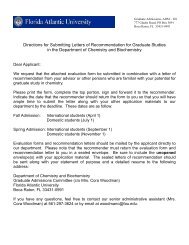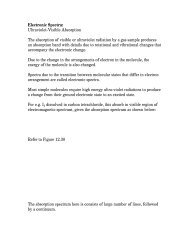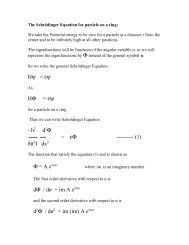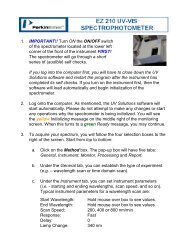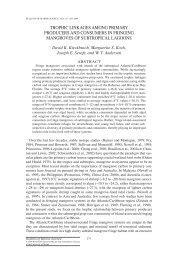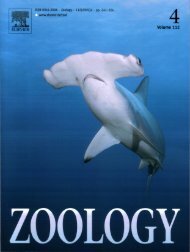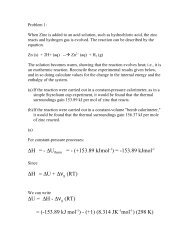Molecular Spectroscopy
Molecular Spectroscopy
Molecular Spectroscopy
Create successful ePaper yourself
Turn your PDF publications into a flip-book with our unique Google optimized e-Paper software.
Electromagnetic Spectrum:Refer to Figure 12.1<strong>Molecular</strong> <strong>Spectroscopy</strong>:Absorption of electromagnetic radiation:The absorptions and emissions of electromagnetic radiation are relatedmolecular-level phenomena of compounds.The frequency (ν) of the electromagnetic radiation and the speed with whichradiation travels (c = 2.99 × 10 8 ms -1 in vacuum) can be used to calculate thewavelength λ of the radiation.Thus, the frequency is equal to the number of waves in the radiations of anapproaching beam that can arrive at receiver in 1s, and this number is equalto c/ λ.So, we can writeorν = c / λλ = c / νThe electromagnetic radiation is also treated as stream of packets, calledphotons. These energies are related to frequency (ν) through Planck relation.ε = h νwhere h = 6.62 × 10 -34 J s
Problem 1:What are the frequency and wavelength of electromagnetic radiation forwhich each quantum has energy of 10 -21 J?The energy and frequency are related to each other by Planck’s relationε = h νwhere h = 6.62 × 10 -34 J sν = ε / h= 10 -21 J / 6.62 × 10 -34 J s= 1.5 × 10 12 s -1The frequency and wavelength are related as:λ = c / ν where c = 2.99 × 10 8 ms -1Beer’s Law:= 2.99 × 10 8 ms -1 / 1.5 × 10 12 s -1= 2.0 × 10 -4 mWhen electromagnetic radiation is passed through a sample, some of theradiation is absorbed by the sample.The radiation absorbed by the sample is at particular frequency or ofparticular frequency range.We will use C for the concentration of the absorbing sample in units ofmoles per cubic meter.
The common concentration unit is M, molarity i.e. number of moles ofsolute per liter of solution.Then the concentration in SI units can be obtained by relation:C = M × 1000 L m -3The decrease in the intensity of an incident light beam as it passes through asample is proportional1. The path length2. The concentration of the absorbing component of the solution and3. Intensity of the beam.Thus, with the proportionality constant k, known as molar absorptioncoefficient,Refer to Figure 12.2We havedI = - k C I dxdI / I = - k C dxIntegration over a length l of the sample, dI / I = d (ln I) and limits between0 to lWe getI I l∫ dI /I = ∫ d (ln I) = - k C ∫ dx
I 0 I 0 0ln I / I 0 = - k C lorI = I 0 e -k C l -------- (1)This is known as Beer’s law or Beer-Lambert LawIn practical analytical use, the equation (1) is converted to base-10logarithms, concentration is expressed in moles per liter, and length ismeasured in centimeters.Also, the intensities of outgoing to the incoming radiation i.e. I / I 0 at anywavelength can be directly measured and is called as transmittance and thebase-10 logarithmic term, log (I / I 0 ) is called as absorbance.Now, writing ε, molar extinction coefficient for proportionality constantWe get,log (I / I 0 ) = ε M lorI = I 0 10 -ε M l -------- (2)The equation (1) and (2) gives us the relation between k and ε as:k = 2.303 × 10 -1 εFor all theoretical purposes, we will use equation (1) and molar absorptioncoefficient k.
Thus, the extent to which radiations of particular frequencies or wavelengthsis absorbed by a sample gives us absorption spectrum.In infrared spectral region, generally amount of absorption is reported aspercent transmission i.e. (I/ I 0 ) 100While in the visible and ultraviolet regions, the absorbance, log (I/ I 0 ) isused.Problem 2:In the infrared absorption spectra of ketones, aldehydes, carboxylic acids,and esters, the carbonyl absorption due to C=O group is prominent feature.For 2-butanone, or methyl ethyl ketone dissolved in carbon tetrachloride thisabsorption occurs at 5.8µm, or 1724 cm -1 . A 0.089 M solution in anabsorption cell of thickness, or length, 0.100 mm gives the absorption bandshown in following figure. Calculate the value of molar absorptioncoefficient at the band maximum.Refer to Figure 12.3From percent transmission values at the center of the absorption band andthat estimated for background we obtainI = 49I 0 = 98ln (I/ I 0 ) = ln (0.5) = - 0.693AlsoC = M × 1000 L m -3= 0.089 mol L -1 × 1000 L m -3= 89 mol m -3
l = 0.100 mm = 1.00 × 10 -4 mln I / I 0 = - k C l-0.693 = - k (89 mol m -3 ) (1.00 × 10 -4 m)k = (0.693) / (89 mol m -3 ) (1.00 × 10 -4 m)= 77.5 mol -1 m 2Rotational Spectra of Linear Molecules:The absorption of microwave radiation increases the rotational energy of themolecules and gives information about the moment of inertia of themolecules.A rotational spectrum is obtained when a sample of gas absorbs far-infraredor microwave radiation and due to this rotational-energy is changed.Rotational energies:We saw that the angular momentum and rotational energy can be given asfollows:Angular momentum = J (J +1) × ( h / 2π)Where J = 0,1,2,3……Rotational Energy = J (J + 1) ( h 2 / 8π 2 I )Where J = 0,1,2,3……
In addition, the value of J is quantized and gives us the total rotational statesfor a particular value of J as 2J +1.i.e. the energy levels specified by the value of J have a degeneracy of 2J + 1Now, in order to express the rotational states of linear molecules, we use arotational constant B given asB = ( h 2 / 8π 2 I )Therefore, we have a rotational energy term asε rot = J (J+1) ( h 2 / 8π 2 I )= J (J + 1) B= BJ (J + 1)where B = ( h 2 / 8π 2 I ) and J = 0,1,2,3….Refer to Figure 12.4Spectroscopic transitions:Most transitions between rotational states of gas phase molecules occur inthe microwave region of the electromagnetic spectrum.The microwave radiation is generated in a radiolike tube known as klystron.Microwave beam can be contained in a metal tube called a wave guide intowhich the gas whose rotational spectrum is to be studied is placed.
The klystron can be tuned to produce various frequencies, and when thefrequency that is absorbed by gas molecules, the electrical properties ofcircuits change. These absorbed frequencies can be measured accurately,thus giving a rotational spectrum of a gas sample. This is also known as farinfraredabsorption spectrum.A rotating molecule interacts with electromagnetic radiation through itselectric dipole.Thus, in order to get a rotational spectra:1. The molecule must have a permanent dipole.Homonuclear molecules like N 2 and O 2 and symmetric molecules likeCO 2 and CH 4 do not produce rotational spectra.2. The transition between the adjacent states; i.e. change in the rotationalquantum number J must obey a selection rule ∆J = ± 1.Rotational Spectra:The rotational spectra or far-infrared or microwave absorption spectra of gascontaining linear polar molecules show regular patterns of nearly equispacedabsorption lines.Refer to Figure 12.5Since, the rotational energies are closely spaced compared to kT, themolecules are distributed through out the lower allowed levels. Therefore,the transition can occur between many levels. The energy differencescorresponds to the energies of the quanta of radiation that bring about ∆J = +1 transition.Therefore, the energy change due to absorption of radiation, due to ∆J = +1is given as:∆ε rot = B(J+1) (J+2) - BJ (J + 1)= B (J +1) [ (J + 2) – J]
= 2 B (J + 1)where J = 0,1,2,3….Refer to Figure 12.6The frequency related quantity called wave number with a symbol ν isdefined as 1 / λ and therefore proportional to frequency, ν = c / λ is oftenexpressed in terms of constant. The wave-number value is reported in unitsof cm -1 .In this, case a rotational constant expressed in wave numbers with units ofcm -1 is represented by B.The value of B with units of cm -1 is related to B with units of joules as:B = h c BWhere h = 6.626 × 10 -34 J s and c = 2.99 × 10 10 cm s -1Thus, using the overbar to indicate the wave-number quantities, we have∆ε rot = ν rot = 2 B (J + 1)where J = 0,1,2,3….Thus, we expect a pattern of lines corresponding to the wave-number values2B, 4B, 6B …. and the adjacent spectral lines are spaced by a constantamount that can be identified as 2B.Using the value of B, the spacing between rotational levels can be used tofind the value of B using expression B = h c B and this can be used tocalculate the moment of inertia.Also, we can use the expression I = µr 2 , where µ is the reduced mass, toobtain the internuclear distance, or bond length of the molecules.
Problem 3:The average spacing between the successive rotational absorption lines ofdiatomic molecules CO(g) is 3.8626 cm -1 . Calculate the moment of inertiaand the length of CO bond from this spectral result.Since the spacing between the rotational levels = 2B = 3.8626 cm -1Therefore,B = 1.9313 cm -1AndB = h cB= (6.626 × 10 -34 J s ) (2.99 × 10 10 cm s -1 ) (1.9313 cm -1 )= 3.836 × 10 -23 JNow, we haveB = ( h 2 / 8π 2 I )I = ( h 2 / 8π 2 B )= (6.626 × 10 -34 J s) 2 / [ (8) (3.142) 2 (3.836 × 10 -23 J )]= 14.50 × 10 -47 J s 2= 14.50 × 10 -47 kg m 2 s -2 s 2
= 14.50 × 10 -47 kg m 2The reduced mass of C-12 and O-16 of CO molecules can be obtained fromthe masses in kilograms and Avogadro’s number asµ = (m 1 m 2 ) / (m 1 + m 2 ) N A= (0.01200) (0.01600) / (0.02800) (6.022 × 10 23 )= 1.139 × 10 -26 kgandI = µ r 2r 2 = I / µ= 14.50 × 10 -47 kg m 2 / 1.139 × 10 -26 kg= 127.3 × 10 -22 m 2r = 112.8 × 10 -12 m = 112.8 pm







